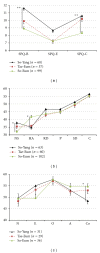Development and validation of a personality assessment instrument for traditional korean medicine: sasang personality questionnaire
- PMID: 22567034
- PMCID: PMC3332171
- DOI: 10.1155/2012/657013
Development and validation of a personality assessment instrument for traditional korean medicine: sasang personality questionnaire
Abstract
Objective. Sasang typology is a traditional Korean medicine based on the biopsychosocial perspectives of Neo-Confucianism and utilizes medical herbs and acupuncture for type-specific treatment. This study was designed to develop and validate the Sasang Personality Questionnaire (SPQ) for future use in the assessment of personality based on Sasang typology. Design and Methods. We selected questionnaire items using internal consistency analysis and examined construct validity with explorative factor analysis using 245 healthy participants. Test-retest reliability as well as convergent validity were examined. Results. The 14-item SPQ showed acceptable internal consistency (Cronbach's alpha = .817) and test-retest reliability (r = .837). Three extracted subscales, SPQ-behavior, SPQ-emotionality, and SPQ-cognition, were found, explaining 55.77% of the total variance. The SPQ significantly correlated with Temperament and Character Inventory novelty seeking (r = .462), harm avoidance (r = -.390), and NEO Personality Inventory extraversion (r = .629). The SPQ score of the So-Eum (24.43 ± 4.93), Tae-Eum (27.33 ± 5.88), and So-Yang (30.90 ± 5.23) types were significantly different from each other (P < .01). Conclusion. Current results demonstrated the reliability and validity of the SPQ and its subscales that can be utilized as an objective instrument for conducting personalized medicine research incorporating the biopsychosocial perspective.
Figures

References
-
- Loehlin JC. Genes and Environment in Personality Development. Newbury Park, Calif, USA: Sage; 1992.
-
- Kretschmer E, Sprott WJH. Physique and Character: An Investigation of the Nature of Constitution and the Theory of Temperament. New York, NY, USA: Harcourt Brace; 1925.
-
- Shipley BA, Weiss A, Der G, Taylor MD, Deary IJ. Neuroticism, extraversion, and mortality in the UK health and lifestyle survey: a 21-year prospective cohort study. Psychosomatic Medicine. 2007;69(9):923–931. - PubMed
-
- Moskowitz JT, Epel ES, Acree M. Positive affect uniquely predicts lower risk of mortality in people with diabetes. Health Psychology. 2008;27(1):S73–S82. - PubMed
LinkOut - more resources
Full Text Sources

